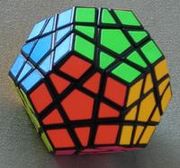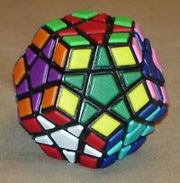
Megaminx
Encyclopedia


Rubik's Cube
Rubik's Cube is a 3-D mechanical puzzle invented in 1974 by Hungarian sculptor and professor of architecture Ernő Rubik.Originally called the "Magic Cube", the puzzle was licensed by Rubik to be sold by Ideal Toy Corp. in 1980 and won the German Game of the Year special award for Best Puzzle that...
. It has a total of 50 movable pieces to rearrange, compared to the 20 movable pieces of the Rubik's cube.
History
The Megaminx, or Magic Dodecahedron, was invented by several people simultaneously and produced by several different manufacturers with slightly different designs. Uwe MèffertUwe Mèffert
Uwe Mèffert has manufactured and sold mechanical puzzles in the style of Rubik's Cube since the original Cube craze. His first design was the Pyraminx and others include the Megaminx, Skewb and Skewb Diamond...
eventually bought the rights to some of the patents and continues to sell it in his puzzle shop under the Megaminx moniker. It is also known by the name Hungarian Supernova, invented by Dr. Cristoph Bandelow. His version came out first, shortly followed by Meffert's Megaminx. The proportions of the two puzzles are slightly different.
Description
The Megaminx is made in the shape of a dodecahedron, and has 12 face center pieces, 20 corner pieces, and 30 edge pieces. The face centers each have a single color, which identifies the color of that face in the solved state. The edge pieces have two colors, and the corner pieces have three colors. Each face contains a center piece, 5 corner pieces and 5 edge pieces. The corner and edge pieces are shared with adjacent faces. The face centers can only rotate in place, but the other pieces can be permuted by twisting the face layer around the face center.There are two main versions of the Megaminx: the 6-color version in which opposite faces have the same color, and the 12-color version in which all faces have a different color.
The purpose of the puzzle is to scramble the colors, and then restore it to its original state of having one color per face.
Solutions
Despite its daunting appearance and greater number of possible positions, the Megaminx is not much more difficult than the standard 3x3x3 Rubik's cubeRubik's Cube
Rubik's Cube is a 3-D mechanical puzzle invented in 1974 by Hungarian sculptor and professor of architecture Ernő Rubik.Originally called the "Magic Cube", the puzzle was licensed by Rubik to be sold by Ideal Toy Corp. in 1980 and won the German Game of the Year special award for Best Puzzle that...
. This is because it is not a deep-cut puzzle; it only has pentagonal face layers which are similar in structure to the square face layers of the cube. There are no pieces that do not have a counterpart on the cube. Many of the techniques employed in the solution of the Rubik's cube can also be adapted for the Megaminx, except those that involve turning the center slice of the cube, since the Megaminx has no equivalent slice.
The 6-color Megaminx comes with an additional challenge which is not immediately obvious. Its edge pieces come in visually identical pairs, because of the duplicated colors of opposite faces. However, although visually indistinguishable, they are nevertheless mathematically bound in a parity relationship. In any legal position (reachable from the solved state without disassembling the puzzle), there is always an even number of swapped pairs of edges. However, since swaps may be between visually indistinct edges, one may find that having solved almost the entire puzzle, one is left with a pair of swapped (distinct) edges that seems to defy all attempts to exchange them. The solution is to swap a single pair of 'identical' edges to reverse the parity, and then restore the rest of the puzzle.
This property is absent in the 12-color Megaminx, because all its edges are visually distinct, and it would be immediately obvious that there is another pair of swapped edges besides the pair one is working with.
Number of combinations
Both versions of the puzzle have 20 corners and 30 edges. In both cases, only even permutations are possible, regardless of the position of the other set of pieces. Thus, while it is possible to have two corners and two edges swapped on a Rubik's Cube, this is impossible on the Megaminx. There are 20!/2 ways to arrange the corners and 319 ways to orient them, since the orientation of the last corner depends on that of the preceding ones. There are 30!/2 ways to arrange the edges and 229 ways to flip them.
The full number is 100 669 616 553 523 347 122 516 032 313 645 505 168 688 116 411 019 768 627 200 000 000 000 (roughly 101 unvigintillion on the short scale
Names of large numbers
This article lists and discusses the usage and derivation of names of large numbers, together with their possible extensions.The following table lists those names of large numbers which are found in many English dictionaries and thus have a special claim to being "real words"...
or 101 undecillion on the long scale).
The corners are distinguishable on a six-color Megaminx because two corners with the same three colors will be mirror images of each other. There are 15 pairs of identical edges. It would not be possible to swap all 15 pairs, since this would be an odd permutation of the edges, so a reducing factor of 214 is applied to the preceding figure.

The full number is 6 144 385 775 971 883 979 645 753 925 393 402 415 081 061 792 664 780 800 000 000 000 (roughly 6.1 vigintillion on the short scale or 6.1 decilliard on the long scale).
Records
Simon Westlund of Sweden set both the single (42.28) and average (49.90) world records at the Danish Open 2011.Variations
More complex variations of the Megaminx have been made, including the Gigaminx, Teraminx and Petaminx. These are 5-, 7-, and 9-layer versions of the Megaminx. A variant with only the corners (equivalent to the ImpossiballImpossiball
The Impossiball is a rounded icosahedral puzzle similar to the Rubik's Cube. It has a total of 20 movable pieces to rearrange, same as the Rubik's Cube, but all of the Impossiball's pieces are corners, like the Pocket Cube.- History :...
) has also been made, called the Kilominx. Gigaminx, Teraminx and the Kilominx are mass produced, although the Mèffert version of the Kilominx is instead called the Flowerminx due to the shape that appears on each face. It uses a modified version of the Pyraminx Crystal
Pyraminx Crystal
The Pyraminx Crystal is a dodecahedral puzzle similar to the Rubik's cube and the Megaminx. It is manufactured and sold by Uwe Mèffert in his puzzle shop since 2008.It is not to be confused with the Pyraminx, which is also invented and sold by Meffert....
mechanism.
Another variant is the Holey Megaminx, which has no center pieces, like the Void Cube
Void Cube
The Void Cube is a 3-D mechanical puzzle similar to a Rubik's Cube, with the notable difference being that the center "cubes" are missing, which causes the puzzle to resemble a level 1 Menger sponge. The central "spider" used on the Rubik's Cube is also absent, creating holes straight through the...
. It is being produced by Mèffert as of July 2009.
See also
- ImpossiballImpossiballThe Impossiball is a rounded icosahedral puzzle similar to the Rubik's Cube. It has a total of 20 movable pieces to rearrange, same as the Rubik's Cube, but all of the Impossiball's pieces are corners, like the Pocket Cube.- History :...
- Alexander's StarAlexander's StarAlexander's Star is a puzzle similar to the Rubik's Cube, in the shape of a great dodecahedron.-History:Alexander's Star was invented by Adam Alexander, an American mathematician, in 1982...
- Pyraminx CrystalPyraminx CrystalThe Pyraminx Crystal is a dodecahedral puzzle similar to the Rubik's cube and the Megaminx. It is manufactured and sold by Uwe Mèffert in his puzzle shop since 2008.It is not to be confused with the Pyraminx, which is also invented and sold by Meffert....
- Rubik's CubeRubik's CubeRubik's Cube is a 3-D mechanical puzzle invented in 1974 by Hungarian sculptor and professor of architecture Ernő Rubik.Originally called the "Magic Cube", the puzzle was licensed by Rubik to be sold by Ideal Toy Corp. in 1980 and won the German Game of the Year special award for Best Puzzle that...
- PyraminxPyraminxThe Pyraminx is a tetrahedral puzzle similar to the Rubik's Cube. It was invented and patented by Uwe Meffert, and introduced by Tomy Toys of Japan in 1981. Meffert continues to sell it in his toy shop, ....
- Skewb DiamondSkewb DiamondThe Skewb Diamond is an octahedron-shaped puzzle similar to the Rubik's Cube. It has 14 movable pieces which can be rearranged in a total of 138,240 possible combinations. This puzzle is the dual polyhedron of the Skewb.- Description :...
- DogicDogicThe Dogic is an icosahedron-shaped puzzle like the Rubik's cube. The 5 triangles meeting at its tips may be rotated, or 5 entire faces around the tip may be rotated. It has a total of 80 movable pieces to rearrange, compared to the 20 pieces in the Rubik's cube.- History :The Dogic was patented by...
- Combination puzzlesCombination puzzlesA combination puzzle, also known as a sequential move puzzle, is a puzzle which consists of a set of pieces which can be manipulated into different combinations by a group of operations. The puzzle is solved by achieving a particular combination starting from a random combination...
- Magic 120-cell
External links
- Meffert's puzzle shop
- Jaap's Megaminx page — contains solutions and other information

